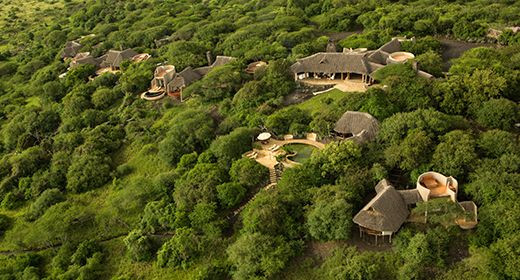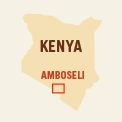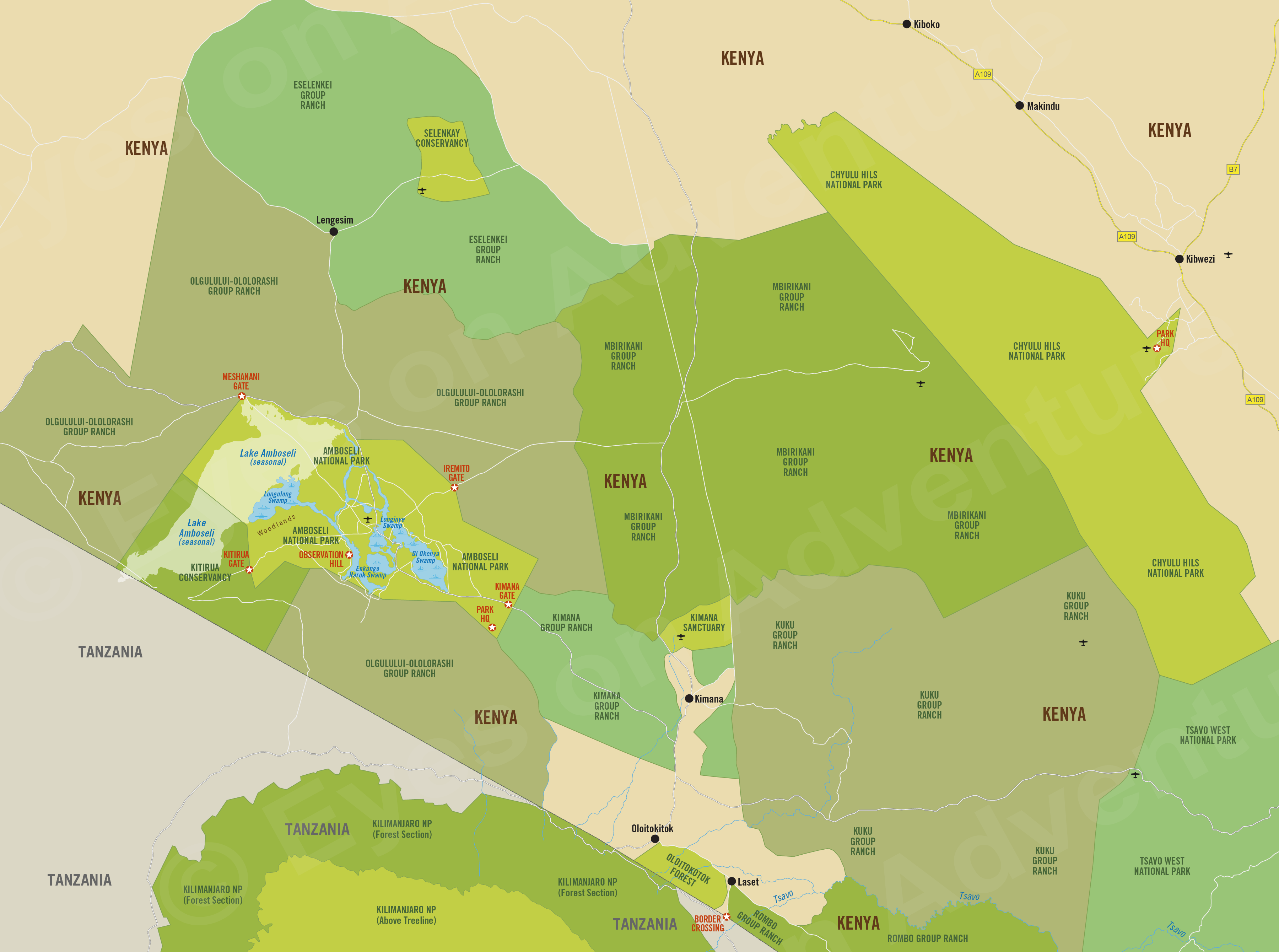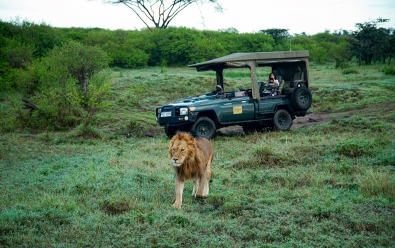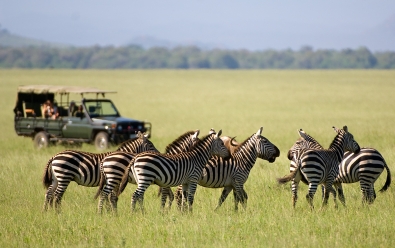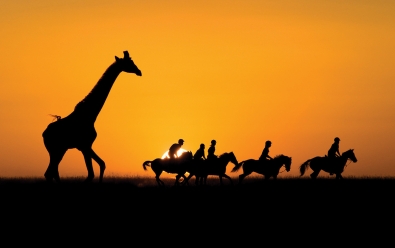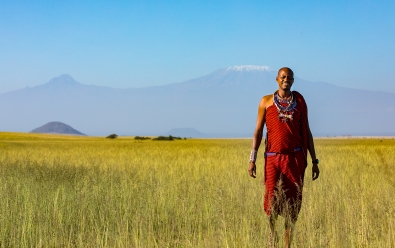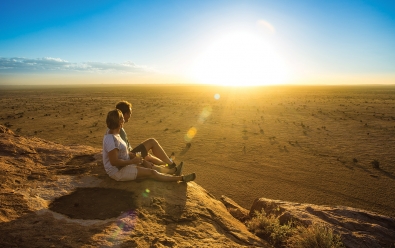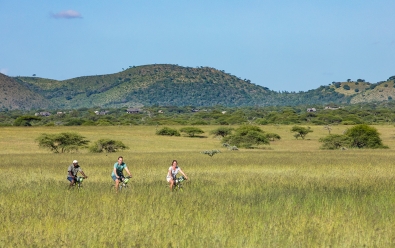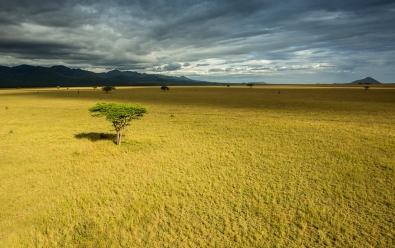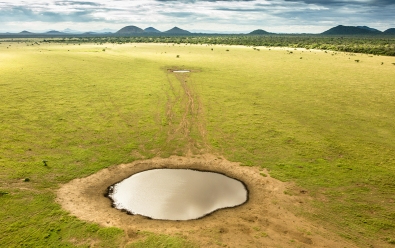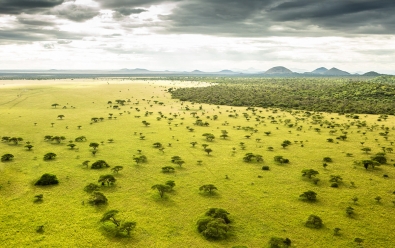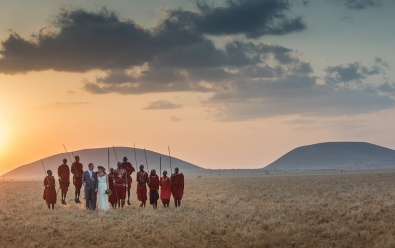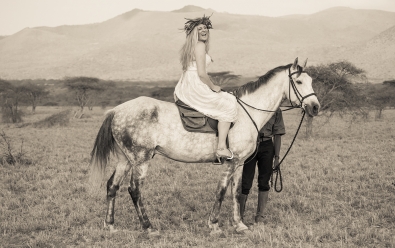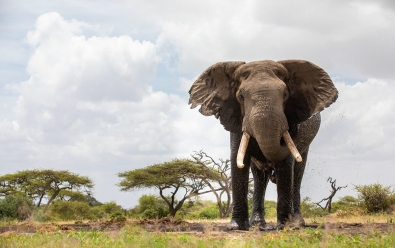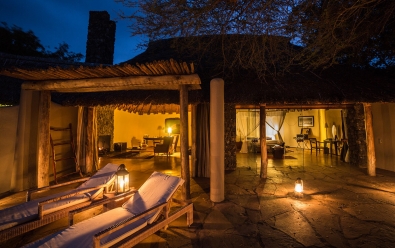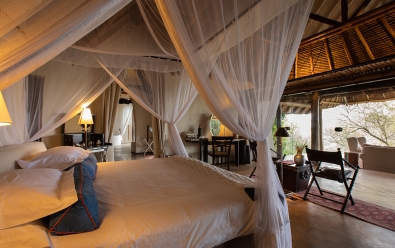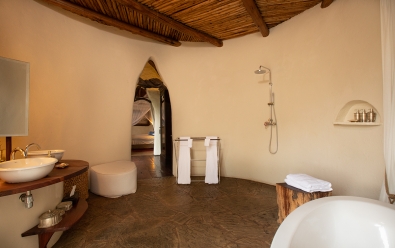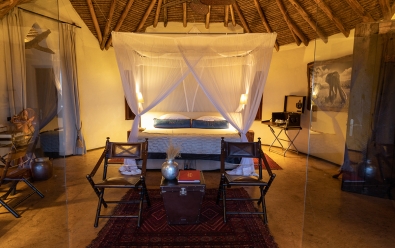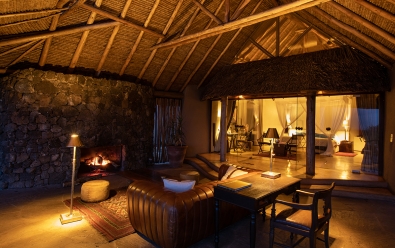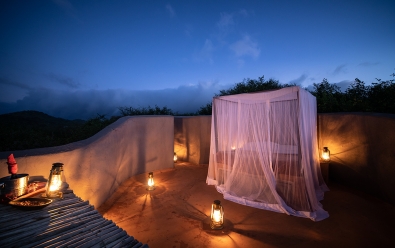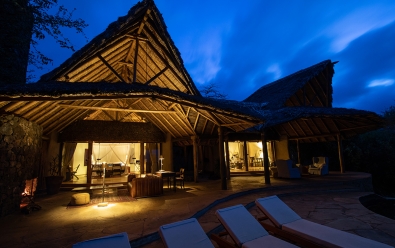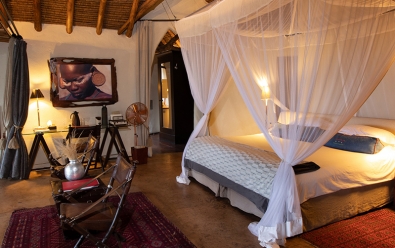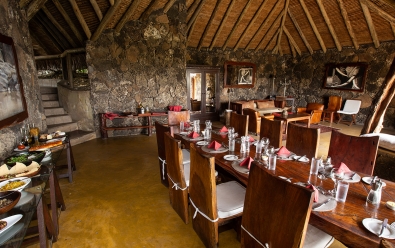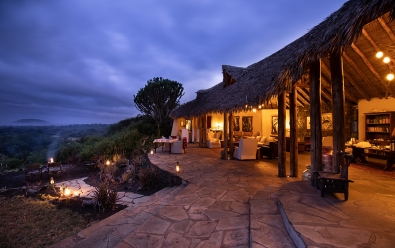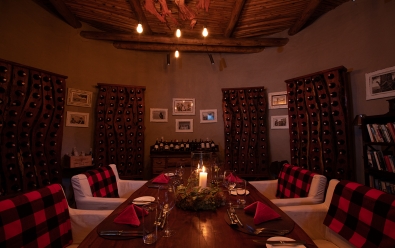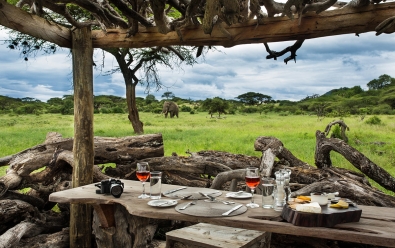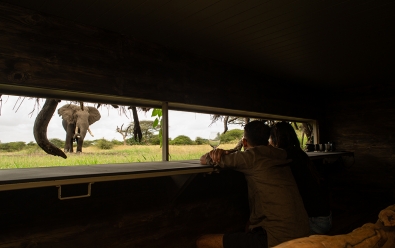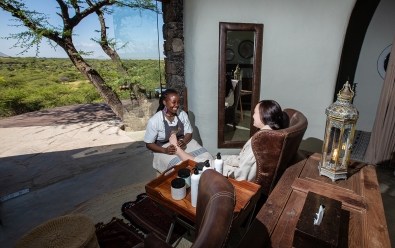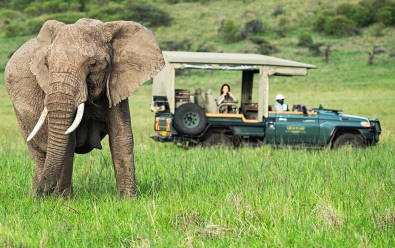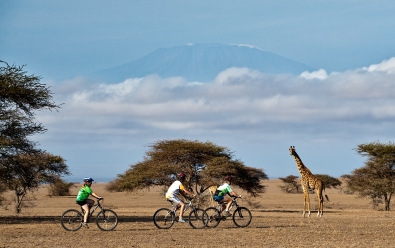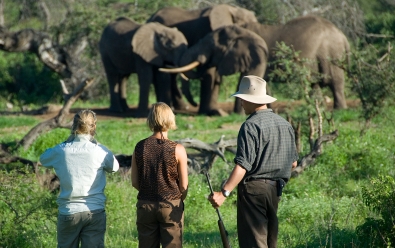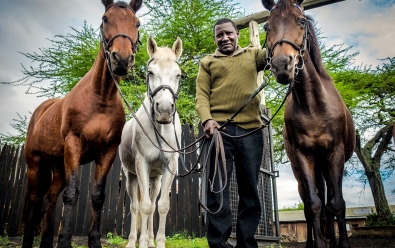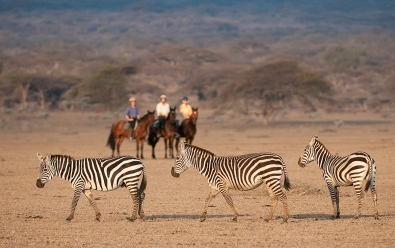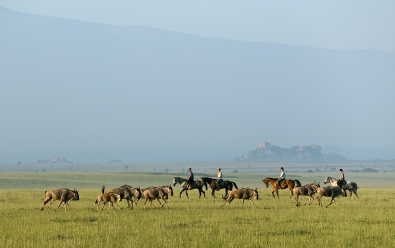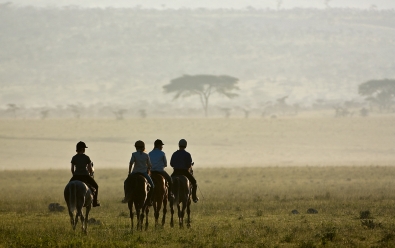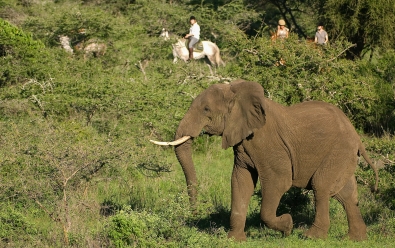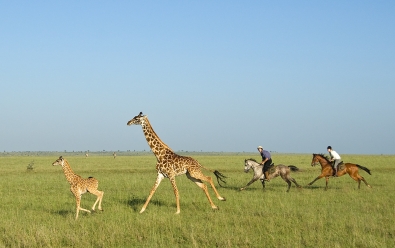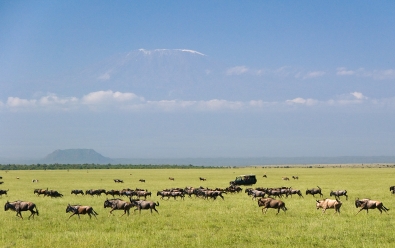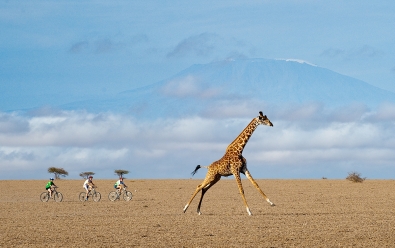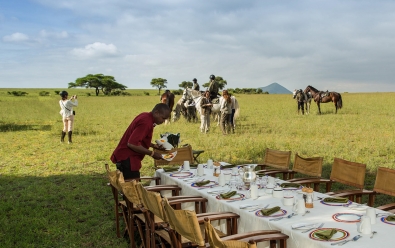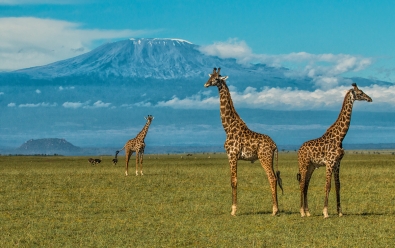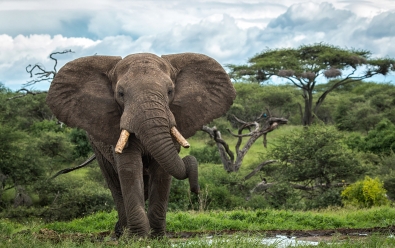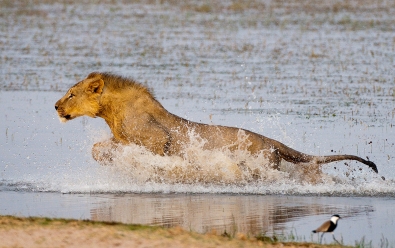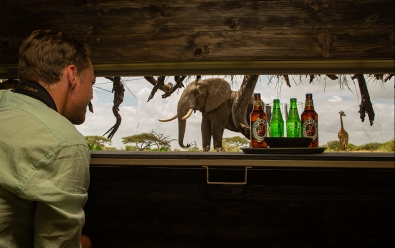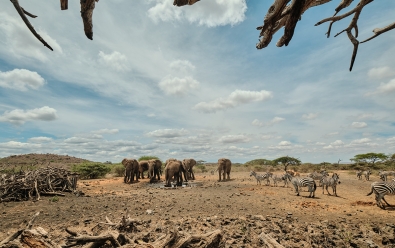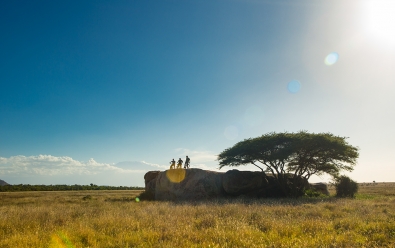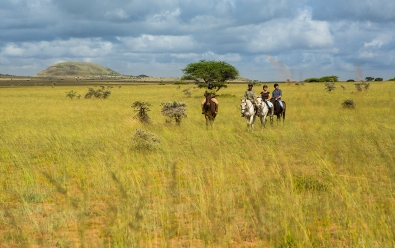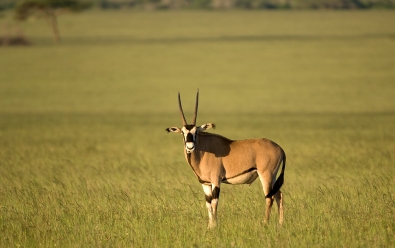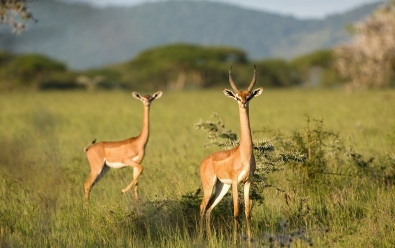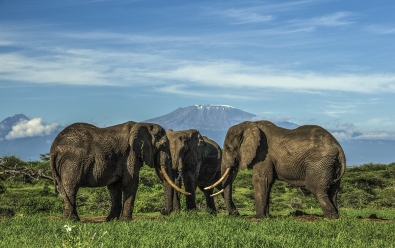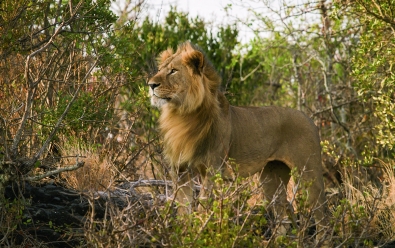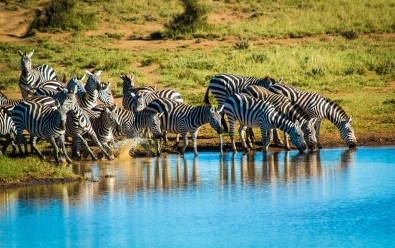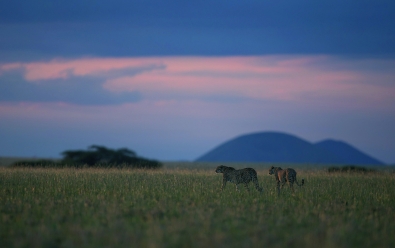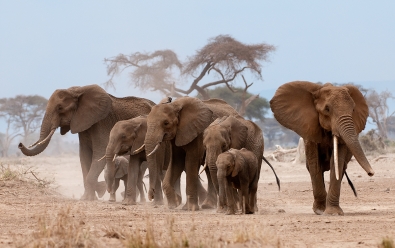Ol Donyo Lodge
Highlights
- Historic lodge in a huge and beautiful wilderness and no other camps.
- Good wildlife viewing, particularly for 'big tusker' elephants.
- Game drives, horseback riding, walking, biking, wildlife hides, culture.
- One of the most beautiful regions in Kenya and very few tourists.
Location
- Mbirikani Group Ranch
- Chyulu Hills
- Southeast Kenya
Set in the remote and stunningly beautiful and verdant Chyulu Hills linking Amboseli to Tsavo, ol Donyo has long been a place to escape the crowds and enjoy diverse wildlife, including some of the last 'big tusker' elephants in Africa.
The lodge is located in the private, 430-square-mile (1 113-sq-km) Mbirikani Game Ranch, which borders Chyulu Hills National Park and is leased from the local Maasai people. This massive tract of fertile land offers a massive tract of grazing land for good numbers of eland, zebra, buffalo, oryx, giraffe and many other species. It is also a key migration corridor for elephants moving between Tsavo to the east, Amboseli to the west, and the Kilimanjaro region to the south.
There are only a few tourist camps within the entire Chyulu region, so guests staying at ol Donyo will enjoy a remarkably exclusive experience with literally no other people anywhere around. Wildlife sightings are nearly always just a single vehicle, providing an extreme contrast to the far busier wildlife destinations further to the west. Read more about Mbirikani and the history of ol Donyo below.
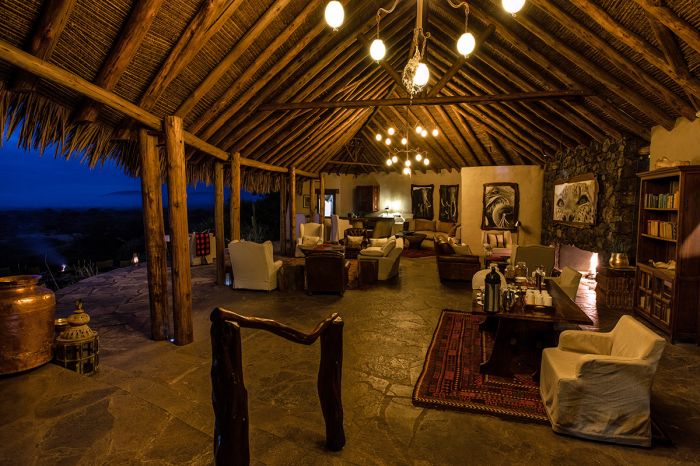
Main area guest lounge at ol Donyo Lodge.
Ol Donyo offer a diverse list of activities to choose from, from safari drives in customized 4x4 vehicles, horseback riding on the lush, volcanic hills and plains, mountain biking, bush walks, spending time in the hide to see wildlife up close and at ground level (thrilling), cultural visits, and more. Full-day safaris to Amboseli National Park are also an option.
Ol Donyo features nine, spacious guest suites made from gunite and wood, with high-pitched thatched roofing and polished cement flooring. Each suite is uniquely-designed in terms of exact layout, but all the suites include a private, outdoor space that features a private pool, as well as a roof-top sleep-out space with a comfortable bed and mosquito netting. Some of the suites also have indoor fireplaces. One of the suites is a double-sized unit with two-bedrooms.
The fully-plumbed, en-suite facilities include a luxurious, deep, stone bathtub, indoor and outdoor showers, a double-basin vanity, and separate flush toilet. Each bedroom includes a complimentary DSLR camera and lenses and a pair of high-quality binoculars for guests to use during their stay.
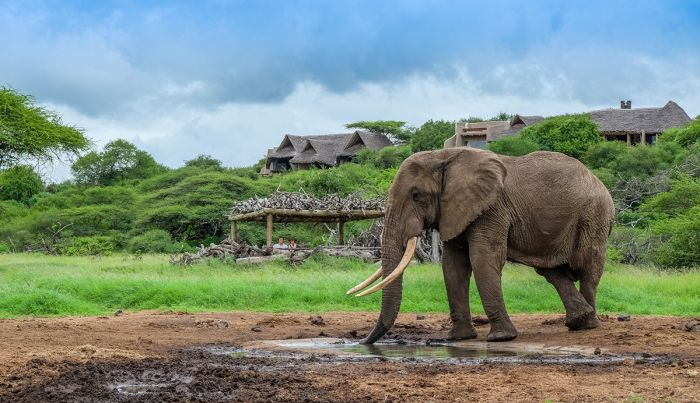
An elephant drinks at ol Donyo's waterhole while guests observe from the hide.
The lodge is built on a lush, tree-covered slope overlooking the vast open plains below with seemingly endless views to the horizon. On clear days, the views extend all the way to Mount Kilimanjaro looming high above the clouds across the border in Tanzania. The camp's pumped waterhole, which is visited by a steady stream of wildlife, can be viewed from the main lodge area, guest suites, or up close at the underground hide located adjacent to the waterhole.
The main lodge consists of a large, semi-open, wood and natural-stone structure with polished cement flooring and high-pitched, thatched roofing. The space features a double-lounge with a bar, grand stone fireplace, an open-air veranda, an indoor dining space, a library, and a coffee/tea station. The outdoor veranda includes an infinity swimming pool and space for al-fresco dining. There is also a spa and the Great Plains Boutique for shopping.

Main area infinity pool and view to elephants at the ol Donyo Lodge waterhole.
Ol Donyo Lodge is owned and operated by Great Plains Conservation, an organization whose mission is to blend sustainable tourism with the conservation of wildlife environments. Great Plains is headed by the husband-and-wife team of Beverly and Dereck Joubert, who are well known to wildlife enthusiasts for their outstanding films, most of which have been created in conjunction with National Geographic.
Great Plains use the term “Conservation Tourism” to describe what they do. They define it as the use of quality-led tourism experiences that are environmentally sound, with the benefits going specifically into making the conservation of an area viable and sustainable.
The Great Plains model takes stressed and threatened environments, surrounds them with compassionate protection and intelligent, sustainable management, and funds them with sensitive, low-volume, low-impact, tourism.
Great Plains are one of Africa's leading safari operators and they strive to minimize energy consumption at all their camps. Ol Donyo Lodge maintains strict eco-friendly environmental standards, so that no harmful chemicals or waste is allowed to enter the Chyulu Hills environment.
Ol Donyo is one of only a few Relais & Châteaux properties in Kenya.
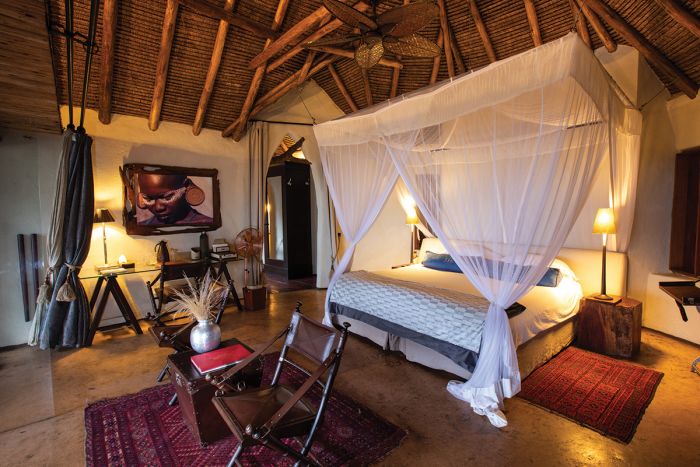
Guest suite interior at ol Donyo Lodge.
THE Amboseli REGION
The Amboseli region is a bridge ecosystem between Tsavo in the east and the Masai Mara-Serengeti ecosystem to the west. This is the spectacular home of Amboseli National Park, which name derives from the Maasai word for "place of dust".
Amboseli is set against the backdrop of Mount Kilimanjaro, located just across the border in Tanzania and the highest peak on the African continent. The seasonally wet Lake Amboseli and the surrounding swamps combine with the vast open spaces, savannas, and woodlands to create a dynamic ecosystem unlike any other in Africa.
Amboseli is perhaps most famous for its elephants, which are here in abundance. The sight of herds walking through the arid landscape with Kilimanjaro as a backdrop is almost too beautiful to believe.
The lands east and north of Amboseli are sparsely populated, with no large urban areas. The land is partitioned into parcels called "Group Ranches" and there are safari camps and various conservation initiatives throughout the region.
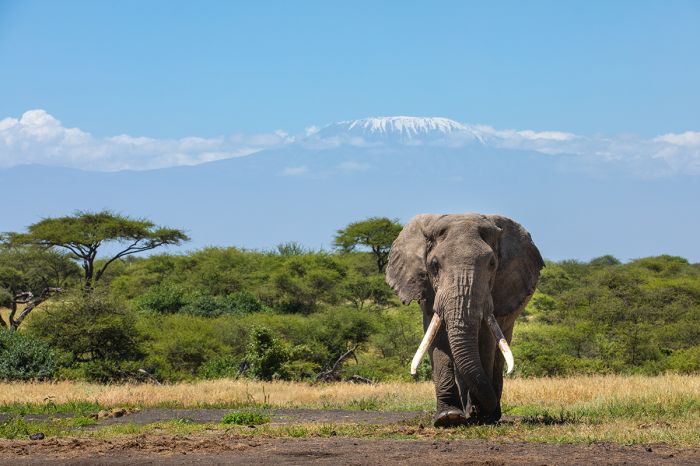
A magnificent bull elephant seen near ol Donyo Lodge with Mount Kilimanjaro rising above the clouds.
ABOUT CHYULU HILLS
Chyulu Hills National Park and its surrounding group ranches offer an amazing, off the beaten path, wild experience in some of Kenya's least visited, but most beautiful country.
Gazetted in 1983, the park covers an area of 182 square miles (471 sq kms) of rolling hills covered in rich grassland with occasional patches of trees. The lava ridge that forms the hills spans around 60 miles (100 kms) in length and was only created recently (~ 500 years ago), and the hills are lush and home to diverse wildlife. The high point on the ridge reaches an elevation of 7 180 feet (2 188 meters).
Game drives and horseback riding are a specialty in the Chyulus. Some of Kenya's last mega-tusker elephants are known from this area. The tops of the hills are covered in verdant cloud forest and are some of the country's most beautiful landscapes.
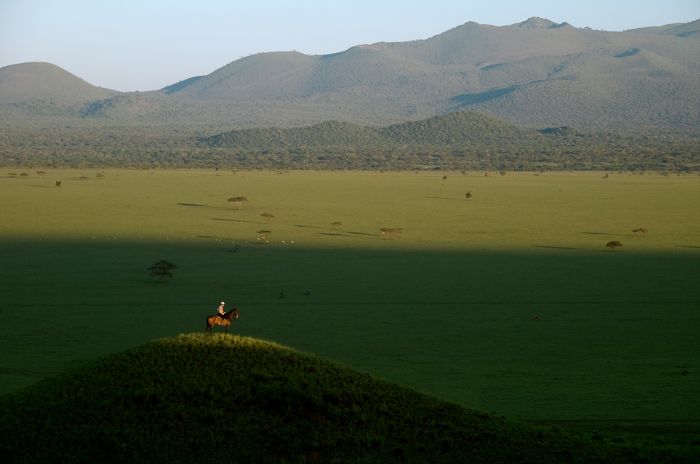
Horseback riding is one of many activities offered at ol Donyo Lodge.
While large numbers of wildlife live in the Chyulu's, they are not heavily concentrated and must be searched for on game drives. All of Africa's Big Five (lion, leopard, elephant, buffalo, and rhino) are present, as well as cheetah, giraffe, zebra, and many more iconic species.
Species likely to be seen in the Chyulu Hills include elephant, Burchell's zebra, buffalo, eland, blue wildebeest, oryx, and Masai giraffe. Interesting and less common species that can be seen include bushbuck, mountain reedbuck, gerenuk, and giant forest hog, which is sometimes spotted in the forested areas.
Predators that are possible, but not often seem include lion, leopard, spotted hyena, black-backed jackal, and cheetah. A small population of black rhino exists under constant surveillance by the Kenya Wildlife Service.
About Group Ranches
In Kenya, a Group Ranch is a tract of land that is shared amongst a number of communities and are most often associated with semi-pastoralist groups and their livestock. The group ranch system was initiated by the Kenyan government in the late 1960s as a way of enabling wider access to natural resources including water and grazing, such that the tribe or persons could not exclude others living nearby from those critical resources.
The results were mixed and today, many of the group ranches are also associated with wildlife and ecotourism. On the negative side, some of the larger group ranches are now being subdivided, which is defeating their original purpose.
Besides its two national parks, Amboseli and Chyulu Kills, the Amboseli ecosystem includes six group ranches: Olgulului-Ololorashi, Kimana, Mbirikani, Eselenkei, Rombo, and Kuku. These six ranches cover about 1 875 square miles (4 850 sq kms) of crucial wildlife corridors between Amboseli, the Chyulu Hills, and Tsavo West National Park.
Mbirikani Group Ranch
The Mbirikani Group Ranch covers a massive 430 square miles (1 113 sq kms) bordering the western side of Chyulu Hills National Park in the western foothills of the Chyulu Range.
Mbirikani is owned by some 4 000 Maasai people. The landscapes here are spectacular and diverse, with rolling grasslands, high-altitude mist-forest, lava fields, dramatic rock formations (created from long-ago eruptions on the Kilimanjaro volcano), hills, inselbergs, including the famous 'twin kopjes', and offering views all the way to Mount Kilimanjaro to the south in Tanzania.
History of ol Donyo
Richard Bonham, the son of a well-known park warden, negotiated a tourism lease with the local Maasai communities and started building ol Donyo in the 1980s. After its completion, the lodge became the Africa cognoscenti’s dream destination. Tucked away in the spectacular Chyulu Hills, above the heat and malaria, and far away from the tourist circuit, ol Donyo Wuas (which was the lodge's original name) was a model for many of the ‘bush lodges’ that were to follow.
Bonham and the local Maasai entered into a partnership and created a pioneering, community conservation, safari-tourism project with the Maasai participating in lodge operations and guiding and benefiting from the travelers that visited their remote homeland.
In the early years, Bonham and his guests would be excited if they even saw tracks of an elephant passing through. Today there are elephants in front of the lodge almost every day, including huge bulls that carry some of the largest tusks remaining in all of Africa.
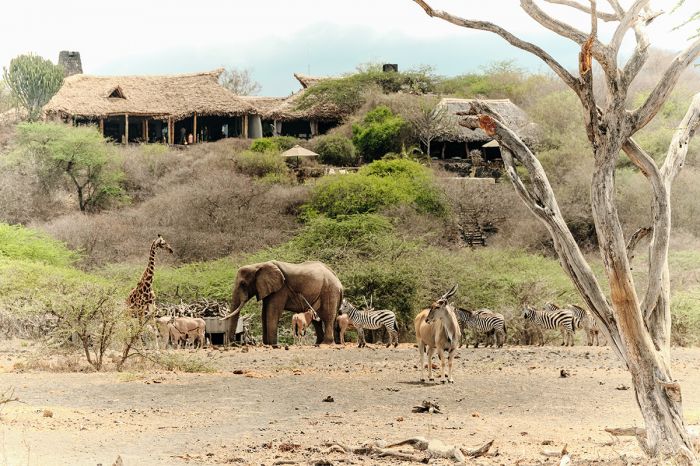
Wildlife gathered at the ol Donyo waterhole with the lodge above.
Lion and cheetah were always present in small shy numbers, but after years of conservation efforts here, their numbers are on the increase. Where once the black rhino had been shot to the brink of extinction, the last of these rhino are protected and today, breeding populations of this highly endangered creature are secure on ol Donyo. Today, the region can boast only continuous, unfenced population of black rhino remaining in Kenya.
Great Plains Conservation took over the lodge ownership and operations in 2008 and have made continuous improvements to the facilities, while maintaining and further fostering the conservation and Maasai community enrichment efforts started by Bonham.
Today, Great Plains supports the salaries of 24 teachers in 15 schools around ol Donyo Lodge. Without additional teachers, student-teacher ratios in government schools in this area would be more than 100 to 1. Their support helps those schools to reduce that ratio, allowing them to dedicate more time and attention to each student.
One of those schools is Enkijape, the only school in the area that specializes in serving over 60 primary school children with physical, developmental, and intellectual disabilities. Learn more at greatplainsfoundation.com.
ROOMS INCLUDES & EXCLUDES CHILDREN FACILITIES ACTIVITIES
Accommodation
9 guest accommodations in total comprising:
- 8 luxurious, double-bedded, pool suites. Twin-bedded setup is also available.
- 1 luxurious, two-bedroom, pool suite. Both bedrooms are a double-bedded setup (convertible to twin) and each has its own en-suite bathroom facilities. The bedrooms share an outdoor space with a private pool and open campfire area. This suite is suitable for maximum of 4 adults or a a family with 2 adults and up to 3 children.
Each spacious, suite is constructed from gunite (sprayed cement) on polished cement flooring and with wooden beams and thatched roofing. The fully-plumbed, en-suite facilities include a luxurious, deep, stone bathtub, indoor and outdoor showers, a double-basin vanity, and separate flush toilet.
The guest suites are connected to the main camp area by a earthen footpaths on the ground.
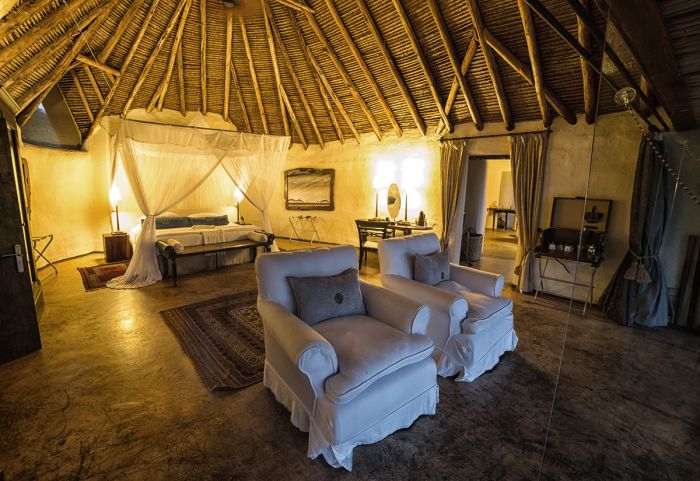
Guest suite bedroom at ol Donyo Lodge.
Each suite is uniquely-designed in terms of exact layout, but all the suites include a private, outdoor space that features a private pool, as well as a roof-top sleep-out space with a comfortable 'star-bed' and mosquito netting. Some of the suites also have indoor fireplaces.
Other features in the guest suites include an indoor sitting space, a writing desk and chair, and plenty of storage space for clothes and personal items. The double-suite includes a private outdoor area with lounge-style seating, a campfire, and space for private dining.
Items and features in all of the guest units include:
- Mosquito netting over the beds.
- Writing desk and chair.
- Electronic safe.
- Standing fan.
- Tea and coffee making facilities.
- Low-voltage hairdryer.
- Yoga mats and bands.
- High-quality binoculars and a professional camera body and lens kit for complimentary use. Photos will be downloaded to a memory stick on guest’s departure.
- Wi-Fi (not always reliable) in the guest suites and main camp area.
- Plug points (British large three-pin) for charging mobile devices.
- Personal amenities, including soap, shampoo, conditioner, and lotion.
- Limited cell service is relatively reliable. No cell phones or computers are allowed in the public areas of camp or on game drive vehicles; only in the privacy of guest suites.
Ol Donyo Lodge can accommodate a maximum of 21 guests in total: 2 guests in each of the 8 standard suites and a maximum of 5 persons (4 adults or 2 adults + 3 children) in the two-bedroom suite.
Includes & Excludes
Includes:
- All meals and alcoholic and non-alcoholic beverages, including premium brand spirits and Champagne.
- Safari experiences (twice-daily or full-day game drives horseback riding, on-road and off-road biking, hiking and walking, and birding) accompanied by an experienced guide in the Mbirikani Group Ranch.
- Visits to the two game-viewing hides at the camp's waterhole.
- Laundry services are provided on a daily basis (weather permitting, items will be returned on the same day). Laundry is dried by the sun and on most days any laundry placed out in the morning will be returned by the evening.
- One pair of high quality binoculars and a professional camera body and lens kit for complimentary use. Photos will be downloaded to a memory stick on guest’s departure.
- Return, scheduled, seat-in-plane air transfers from Nairobi's Wilson Airport, as well as inter-camp air transfers from properties in the greater Chyulu Hills / Amboseli region to this camp (subject to a minimum 2-night stay).
- Ol Donyo airstrip transfers.
- Wi-Fi access.
- Tourism Levy & VAT.
Excludes:
- Day-trips to explore Amboseli National Park.
- Spa services.
- Purchases from the Great Plains Boutique.
- Any applicable wildlife fee, park fee, reserve fee, concession fee, other land-use fee.
Single Supplement
A single supplement may apply for any room booked by a single traveler; please ask us for pricing.
Children
Children aged 5 years and older are accommodated at ol Donyo Lodge:
- Triples for children sharing with adults mat be available upon request.
- Child rates are applicable for one child aged 15 years and younger, sharing with two adults in a suite.
- Children 15 and younger must share a room with at least one adult.
- Children aged 16 years and older will pay applicable adult rates and be accommodated in a separate suite. Alternatively, families should consider booking the two-bedroom suite, which accommodates up to 2 adults and 3 children (5-15 years of age).
- Families with children (5-15) will never be accommodated in the same vehicle as other guests.
- Activities will cater to family ability & safety. Some activities may have a specific age related restriction.
- Horse riding is available to guests aged 12 years and above. Some experience required; no beginners.
- Walking activities are available to guests aged 12 years and above.
- Young children must be supervised by their parents, as the camp is not fenced and is located in an area with wild animals.
- The Great Plains Young Explorers program is thoughtfully designed to give children a range of experiences and topics from birding to cooking to art to wildlife tracking.
Facilities
Ol Donyo Lodge is situated very close to the boundary of Chyulu Hills National Park in the western foothills of the Chyulu mountain range.
The lodge is built on a lush, tree-covered slope overlooking vast open plains below with seemingly endless views to the horizon. On clear days, the views extend all the way to Mount Kilimanjaro, over the border in Tanzania.
The camp's regularly-used, pumped waterhole can be viewed from the main lodge, guest suites, or up close at either of the camp's two hides (one underground and one a ground-level woodpile) located adjacent to the waterhole.
The camp is situated far from any other safari camps and guests staying here will enjoy the feeling of being alone in a wilderness, with only the wildlife and camp staff for many miles in all directions.
The main lodge consists of a large, semi-open, wood and natural-stone structure with polished cement flooring and high-pitched, thatched roofing. The space features a double-lounge with a bar, grand stone fireplace, an open-air veranda, an indoor dining space, a library, and a coffee/tea station.
The outdoor veranda includes an infinity swimming pool and space for al-fresco dining. Steps lead down from the pool deck to a footpath that descends down the slope to the wildlife hide at the waterhole, which attracts wildlife on a daily basis.
The main guest area also includes a beauty spa and the Great Plains Boutique for shopping. The large solar-panel farm that powers the camp is located behind the camp.
Main guest area facilities include:
- Double lounge space, dining room, bar, and a coffee/tea station.
- Natural stone fireplace
- Wine storage room with a dining table.
- A large, elevated outdoor veranda with an infinity pool, views down to the wildlife waterhole, and space for poolside dining.
- Outdoor campfire area.
- Two hides at the waterhole for up-close wildlife-viewing.
- Dining is typically communal, but private dining is available on request on the veranda of your guest suite or beside the main pool.
- All dietary requirements are catered for, from regular to vegan to children; prior notice required.
- A range of wellness treatments is offered in the ol Donyo Spa. All ingredients used in the spa treatments have been personally chosen by Dereck and Beverly Joubert, in conjunction with Spacology. Spa treatments are at an additional cost.
- The Great Plains Safari Boutique offers locally and regionally-produced crafts, many of which support local community projects in the nearby Okavango panhandle. The Boutique also stocks Dereck and Beverly Joubert's clothing line, which is a bespoke range of clothing they typically wear and which is ideal and cool while on safari, yet also elegant when in the city. All materials are responsibly sourced.
- Complimentary Wi-Fi access (service may be intermittent).
- Limited mobile phone signal (phone usage is only permitted in the guest suites and not in the common areas of camp nor on activities).
- Mineral water is provided in the main camp areas and in the guest suites.
- The camp is run by combination of solar and generator power. The system produces 220-volt, 24-hour electricity to the suites and main areas. There are plug points (British large 3-pin) in each suite.
Activities
There is a diverse list of activities to choose from at ol Donyo, from safari drives in customized 4x4 vehicles, horseback riding on the lush, volcanic hills and plains, mountain biking, bush walks, day visits to Amboseli, and more.
Activities included in the rate:
- Twice daily (or full-day with picnic lunch) game drives in the vast Mbirikani Group Ranch. Drives after dark are also offered. The vehicles are custom-built Land Cruisers that are designed specifically for the conditions around the camp. The vehicles have fully-stocked fridges with drinks and snacks.
- Horseback riding (see details below).
- Mountain biking.
- Bush walks.
- Spending time at the waterhole (there are two hides, one underground and the other a ground-level woodpile) for up-close wildlife viewing.
- Hill hikes and exploration of the ancient, volcanic lava tubes.
- The camp is extremely flexible on meal timings and picnic breakfasts, lunches are the norm to ensure maximum time on activity!
- Each guest suite includes the use of a professional camera body and lenses. Photos will be downloaded to a USB flash stick on guest’s departure. The suites also include a pair of high-quality binoculars for use during your stay.
- Birding.
Horseback Riding (included in the rate):
With 275,000 acres of open plains and the dramatic, ancient volcanic soil of the Chyulu Hills to explore, ol Donyo offers a truly unique riding experience. Riding is available all year and at no additional cost.
The lodge keeps a herd of 20 horses from 15.1 to 17.1 hands. All of the horses are well schooled and used to the environment shared with the wildlife. The ol Donyo stables boast an impressive range of breeds, including Friesian and Shire crosses, Arabian breeds, and the South African Boerperd. The horses are chosen for their laid-back temperament, endurance, and versatility, hand picking the perfect safari horses visitors coming to see the Chyulu Hills.
All riders will need to have a short assessment in our arena prior to setting out to ensure all guests riding out can control their horse and are comfortable at a short trot. If riders do not have the required experience they will be offered a lesson in the arena instead. Plains riders will be given some instruction. A minimum requirement is a short trot. Horseback riding is done in a range of terrain for abilities from novice to advanced.
- Rider Experience: For intermediate-level and above, there are 2- and 4-hour rides to explore the area. Novice riders can enjoy a gentle 60- to 90-minute ride to explore the open plains. Age restriction is 12 years for all rides.
- Riding Times: Rides take place at 7:15am and 4:00pm subject to availability of guides and horses.
- Tack: The horses are ridden with English bridles and bits and riders can choose an English or Trail saddle.
- Group Size: There is a maximum of 6 guests accompanied by 2 experienced guides.
- Rider Equipment: A selection of riding hats, riding boots, breeches, and half chaps are available for guests at no additional charge.
- Weight Limit: Respectfully, no riders over 209 pounds (95 kgs). The lodge has several large, advanced-level horses that are suitable for riders near the weight limit.
- Rider Age Limit: For safety reasons, the minimum age for riding is 12 years. All children between 12 and 15 years must be accompanied by a riding parent or guardian. All guests, including younger children, are welcome to visit the horses and feed them treats.
Optional activities at additional cost:
- Private activities are on offer (subject to vehicle availability which needs to be booked in advance).
- Day-trip safaris to Amboseli National Park with a picnic lunch packed.
- Cultural village visits.
- Anti-poaching tracker dog experience.
- Lion tracking (subject to availability of researcher).
Example of a typical day:
- Early morning wake-up call. Morning wake-up and activity times vary according to the seasons, activities on offer, and wildlife sightings. Full-day activities and afternoon drives extending past dark are possible.
- Light breakfast before departing on the morning activity.
- Return to the lodge for a meal and rest period (full-day drives bring a picnic lunch or have it delivered by the camp).
- Meet for afternoon tea and snacks (savory and sweet choices) before departing on the activity.
- Return to camp - freshen up or meet for drinks, followed by dinner.
- Enjoy a nightcap or discussion around the fire before retiring.
Great Good Fair Poor
- Jan
- Feb
- Mar
- Apr
- May
- Jun
- Jul
- Aug
- Sep
- Oct
- Nov
- Dec
GENERAL TIPS
The Amboseli-Chyulu region is a very good destination for much of the year, but the recommended time is during the dry months between June and October and again in January and February. This said, visiting during the rainy months can also be great if you are lucky with some sunny days, as the rich new grasses carpet the slopes and become spectacularly good for attracting abundant grazers where there has been good rainfall.
The Amboseli-Chyulu region experiences most of its rain between November and May, but there are two somewhat distinct rain seasons, the 'short' rains and the 'long' rains.
The entire area is prone to drought, during which time plants and animals fight for their survival and demonstrate an amazing ability to survive.
ol Donyo Lodge is open year-round.
Temperatures
The temperatures in the Amboseli-Chyulu region do not have great variation throughout the year, as it lies only 2-3 degrees south of the equator. In general, daytime temperatures are comfortably warm and overnights and early mornings are chilly. Bring a fleece layer regardless of the timing of your visit.
Dry Season
The dry season (June to October) is sunny and warm most days and there is almost never any rain. From June thru August, the afternoon temperature averages 75-79°F (24-26°C), but some days can be warmer. Evenings and early mornings temperatures are often chilly, averaging 57-59°F (14-15°C).
September and October days are very pleasant, with temperatures averaging 80-84°F (28-39°C), with cool mornings persisting, averaging 57-59°F (14-15°C).
During the dry season, it is definitely worth a day trip to visit Amboseli National Park. Amboseli is an arid, dusty place, with Mount Kilimanjaro covered in heat haze on most days.
Despite the dust, photographers will love this time of year, as swirling dust-devils (like miniature tornados) cross the dried plains, sucking clouds of dust hundreds of feet up into the air, making for amazing imagery. Zebras, impalas, giraffes and elephants also kick up dust, making for some incredible imagery. Sunsets during the dry season are also spectacular.
Rainy Season
The rainy season is November through May (read more below) and the temperatures are fairly static throughout the season. Daytime temperatures average 80-85°F (27-29°C) and nighttime and early morning temperatures are cool, but slightly warmer than the dry season, averaging 61-63°F (16-17°C).
Rainy Season
Short Rains
The short rains occur for about one month sometime during November and December (the exact time varies somewhat year to year). This period is called the 'short' rains because the duration of an individual rain event is short and it is rare to have an all-day rain event. Most rain falls as an afternoon shower, while mornings are typically overcast or clear.
Long Rains
The long rains occur between March and May, with April being the wettest month of the year. During this time, rain should be expected almost every day and the showers can last for hours at a time, although all-day rain is not typical. During the long rains, the roads in the region can become muddy and difficult in places, which can hamper game drives. Cloudy skies are typical and temperatures can be chilly at times.
The period between the short and long rains (January and February) also receives rain, but many days are clear and the amount and duration of the rain events is unpredictable, with some afternoon showers and the odd long and heavy rainfall event.
The rainy season (during good rain years) transforms the national park into a verdant landscape, with Lake Amboseli and other seasonal ponds and lakes throughout the region become partially filled with rain water. These oases of life attract flocks of flamingos, pelicans, and other migratory bird life, creating an amazing spectacle. Some of the elephants and other wildlife disperse into the surrounding areas if the rains have been especially good.




